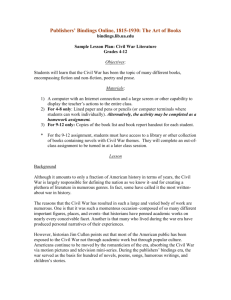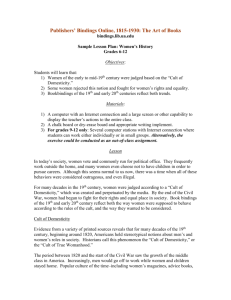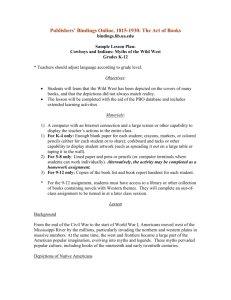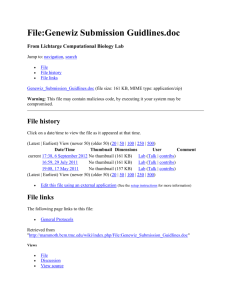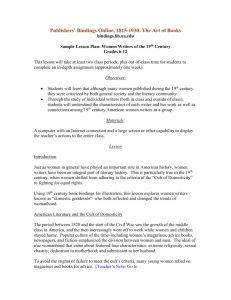Sample Lesson Plan: Women`s History
advertisement
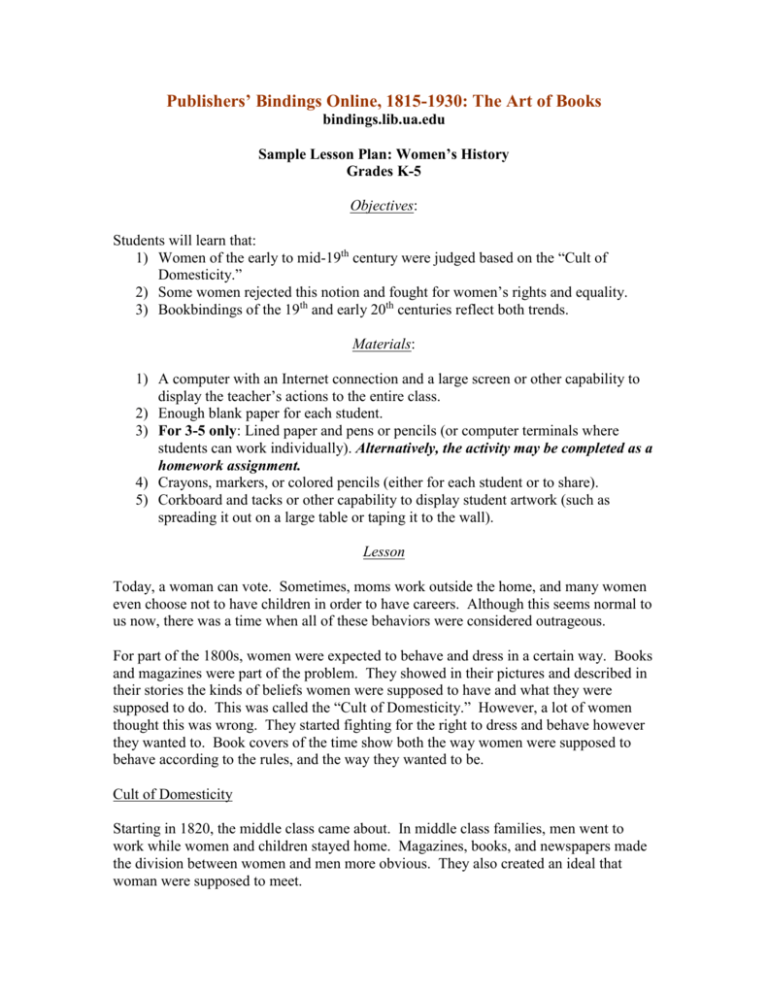
Publishers’ Bindings Online, 1815-1930: The Art of Books bindings.lib.ua.edu Sample Lesson Plan: Women’s History Grades K-5 Objectives: Students will learn that: 1) Women of the early to mid-19th century were judged based on the “Cult of Domesticity.” 2) Some women rejected this notion and fought for women’s rights and equality. 3) Bookbindings of the 19th and early 20th centuries reflect both trends. Materials: 1) A computer with an Internet connection and a large screen or other capability to display the teacher’s actions to the entire class. 2) Enough blank paper for each student. 3) For 3-5 only: Lined paper and pens or pencils (or computer terminals where students can work individually). Alternatively, the activity may be completed as a homework assignment. 4) Crayons, markers, or colored pencils (either for each student or to share). 5) Corkboard and tacks or other capability to display student artwork (such as spreading it out on a large table or taping it to the wall). Lesson Today, a woman can vote. Sometimes, moms work outside the home, and many women even choose not to have children in order to have careers. Although this seems normal to us now, there was a time when all of these behaviors were considered outrageous. For part of the 1800s, women were expected to behave and dress in a certain way. Books and magazines were part of the problem. They showed in their pictures and described in their stories the kinds of beliefs women were supposed to have and what they were supposed to do. This was called the “Cult of Domesticity.” However, a lot of women thought this was wrong. They started fighting for the right to dress and behave however they wanted to. Book covers of the time show both the way women were supposed to behave according to the rules, and the way they wanted to be. Cult of Domesticity Starting in 1820, the middle class came about. In middle class families, men went to work while women and children stayed home. Magazines, books, and newspapers made the division between women and men more obvious. They also created an ideal that woman were supposed to meet. 1) [Go to “Guided Search” on the PBO site, and type “pbw00794” in the first search box. Click “search.” Click on the thumbnail that appears, and then enlarge the image by clicking on the largest box below it.] Women had to be religious. She was supposed to take her family to church and read the Bible to them, like the woman on the cover of this book is doing. She also would tell other people not to sin. 2) [In “Guided Search,” type “pbw00930” in the first search box. Click “search.” Click on the thumbnail that appears, and then enlarge the image by clicking on the largest box below it.] Women were supposed to dress like a “lady.” Their clothes hid their entire bodies, except for their faces. Like the woman on this book cover, they wore dresses with long sleeves and long skirts. When they went outside, they wore hats and gloves, even in the summertime. 3) [In “Guided Search,” type “pba00553” in the first search box. Click “search.” Click on the thumbnail that appears, and then enlarge the image by clicking on the largest box below it.] The home was seen as the proper place for a woman. She would be seen as better suited to raise the children than her husband. The “normal” job for a woman–like the one on this book–was motherhood. 4) [In “Guided Search,” type “pbw00884” in the first search box. Click “search.” Click on the thumbnail that appears, and then enlarge the image by clicking on the largest box below it.] Even though women were better at raising kids, men were seen as better in every other way. Women would let men make all the decisions, even about who would run the country. This book shows a woman and man reading together. Because the man would be seen as better than the woman, he is sitting at the table reading the book while the woman sits beside him with her hands on her lap. The Movement for Women’s Rights Some women thought they were just as good as men, and they wanted everyone else to think so as well. They wanted to be able to vote and to work at jobs outside the home. Soon the ideas about women changed, and the covers of books showed the changes. [In “Guided Search,” type “pba00662” in the first search box. Click “search.” Click on the thumbnail that appears, and then enlarge the image by clicking on the largest box below it.] Women did not have to wear clothes that covered their whole bodies anymore. Like the woman on this book cover, women started wearing dresses that showed some of their skin. [In “Guided Search,” type “pba00560” in the first search box. Click “search.” Click on the thumbnail that appears, and then enlarge the image by clicking on the largest box below it.] Books also began showing women doing things that only men could do before, such as riding bicycles and horses. The woman on this book not only is riding a horse, but she is hunting with men. She is riding in front of the men, which makes it appear that she is better than them. [In “Guided Search,” type “pba00683” in the first search box. Click “search.” Click on the thumbnail that appears, and then enlarge the image by clicking on the largest box below it. Click on “other part” to show the dust jacket.] So, women no longer were expected to stay home all the time. Many began working at jobs other than as wives and mothers. The cover of this book shows a woman with a shovel, surrounded by other tools, probably doing a job that only a man could do before. [In “Guided Search,” type “pba01398” in the first search box. Click “search.” Click on the thumbnail that appears, and then enlarge the image by clicking on the largest box below it.] Women started making important decisions, too. In 1920, women finally were allowed to vote. Even before then, women were elected to political office. This book shows an important woman approaching a government building. Summary The role of women in society changed dramatically between 1820 and 1920. During a lot of the 1800s, women were judged by what society, books, and magazines said they should be. As women began fighting for their rights, women were able to do things they weren’t able to do before, such as wear clothing that showed their skin and ride horses. They also were able to vote and work outside the home, just like men. Book covers of the 1800s and early 1900s show how the ideal of womanhood changed over time. Student Activities: Activity 1 (Grades K-2) Just as book covers in the 1800s and early 1900s showed how women were at the time, current book covers can show how women are now. [Distribute paper and coloring implements.] Tell students to draw their own book cover showing how they think women are today. Encourage creativity. [After students complete their work, display the covers so students can see all of their classmates’ designs.] Activity 2 (Grades 3-5) – This activity may carry over into the next class session Just as books and magazines in the 1800s and early 1900s showed how women were at the time, current media can show how women are now. In this activity, students will write a short story in which the main character is a woman. It can be a woman they know or one that they make up, as long as the story reflects how they think women are today. Stories can be hand-written or typed on a computer. The teacher may choose to have students complete the activity in class or as a homework assignment. Students also will draw a picture illustrating their story, as if their story were a book and the illustration were the cover. After students complete their work, the teacher may display the “covers” so that students can see all of their classmates’ designs. In addition, all of the students (or those who volunteer) should have an opportunity to read their story to the class and explain how it reflects the current status of women. For additional teaching resources on Women’s History, see: National Women’s History Project, Learning Place, American Memory, Library of Congress, http://www.nwhp.org/tlp/links/links.html. Votes for Women: Selections from the National American Women’s Suffrage Association Collection, 1848-1921, American Memory, Library of Congress, http://lcweb2.loc.gov/ammem/naw/nawshom.html. Women in America, University of Virginia, http://xroads.virginia.edu/~HYPER/DETOC/Fem/home.htm. Women in American History, Encyclopedia Britannica, http://search.eb.com/women/studyguide/index.html. Women Who Changed History, Scholastic, http://teacher.scholastic.com/activities/women/index.htm.
